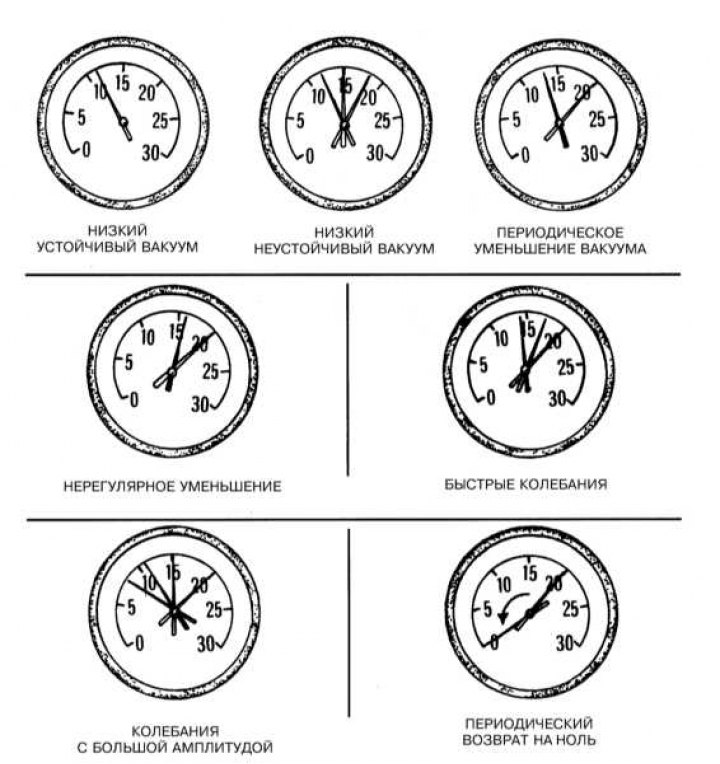
The main positions and oscillations of the vacuum gauge pointer when diagnosing engine malfunctions
Note. For diesel engines, a compression tester with a measuring range of up to approx. 40 bar is required.
The engine must be warmed up to operating temperature, the battery must be fully charged. You will also need the help of an assistant.
Remove the fuel pump fuse from the mounting block, (contact the head Onboard electrical equipment). Start the engine and wait until it stalls. If the engine does not start, crank the starter for about 10 seconds.
To gain access to the spark plugs, remove the oil filler cap and remove the plastic engine cover. Replace the cover.
Disable the ignition system by disconnecting the connector from the ignition coil. Remove all spark plugs (see Section Checking and replacing spark plugs, checking the condition of high-voltage wires (petrol models) Chapters Current service).
Install a compression tester in the hole of the spark plug of the first cylinder. It is advisable to use a compression gauge, the tip of which is screwed into the hole of the candle.
Have an assistant keep the accelerator pedal fully depressed and engage the starter. After several cycles, the compression in the cylinder will reach its maximum value and will no longer change. Write down the result.
The maximum allowable pressure difference in the individual cylinders can be 3.0 bar (for diesel engines 5.0 bar).
Compression in a serviceable engine rises very quickly. A low reading after the first cycle, increasing with successive cycles, indicates worn piston rings. A low value after the first cycle, not increasing after the next, signals that either the valves are leaking or the head gasket is blown (Could also be a cracked head). The presence of soot on the valve plates can lead to a decrease in compression.
Please note that due to the different starter rotation speeds on different models, the measured results may vary. The results obtained when measuring compression should be approximately the same for all cylinders.
If the pressure in any cylinder is at the minimum allowable level or even lower, then follow these steps to find out the cause. Pour a teaspoon of engine oil into the cylinder through the spark plug hole and repeat the compression measurement.
If the addition of oil temporarily improves compression, the cause of the decrease is most likely piston, ring, or cylinder wear. If there is no increase in compression, then it can be assumed that the cause is valve leaks or a broken head gasket.
Low compression in two adjacent cylinders is almost certainly the result of a blown head gasket. The presence of coolant in the combustion chambers or in the crankcase will confirm this assumption.
If the compression in one of the cylinders is about 20% lower than in the others, besides, the idle speed is unstable, then the cause may be excessive wear of the camshaft cam.
After completing the check, reinstall the spark plugs (contact the head Current service), put on them tips of high-voltage wires, connect the connector to the ignition coil. Reinstall the plastic engine cover and fuel pump fuse.
Compression pressure values for various engines are given in Specifications.
Leak test
During this test, the rate of exit from the cylinders of the compressed air pumped into them and the leaks directly are determined. This test is an alternative to the compression test. Moreover, from many points of view, it is much more effective, since visually identifying the source of a leak is easier than comprehending the results of a compression measurement.
The equipment needed to test for leaks is not publicly available, so this test will have to be entrusted to the service center specialists.
